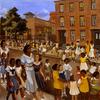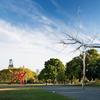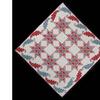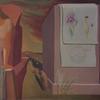Charles Alfred Meurer (American 1865 - 1955)
- March 08, 2022 07:45
Charles Alfred Meurer’s mother was visiting family in Germany when she gave birth to Charles. They returned to Clarksville, Tennessee where Meurer grew up. In 1881 he moved to Cincinnati, Ohio and was in the grocery business with his brother, when in in 1882, he bought some artist’s brushes and colors and painted during his spare time. One painting, a panorama of Clarksville done from the top a nearby hill, showed so much promise that he enrolled in classes at the Cincinnati Art Academy in 1885 and took study with T.S. Noble, Frank Duvenek and L.H. Meakin. It was Harnett’s painting, "The Old Violin," which was exhibited at the Cincinnati Centennial in 1888, that made such an impression on him that he took up the study of still life, which in a few years was to make him famous. During this same time, Meurer, took a fling at acting, and spent a short season "barn-storming" with a minstrel show, but the show failed in Richmond, Indiana, and young Meurer decided that he had better stick with painting. In 1891 he went to Europe, studying a year in Lyons, France under Parrache and Tollet, masters in figure and flower painting, and a year in the famous old Quartier Latin of Paris, where he studied at the Ecole des Beau Arts with Gabriel Ferrier and Henri Doucet, and the Académie Julien under William Adolph Bouguereau, Jean Paul Laurens, and Benjamin Constant. He also toured the Mediterranean countries, where he made many sketches and sea views, and visited a number of the picturesque portions of Germany, Switzerland and France. Meurer became the protégé of Georges Ratye, owner of the feudal land castle of Chateau Escanin. Under the patronage of Monsieur Raytye, Meurer’s talent developed rapidly, and it was during this period that he painted his first masterpiece, the now infamous, "My Passport." created such a furor in Europe that Meurer shipped it to the World’s Columbian Exhibition, which was to be held in Chicago, in 1893. It was his specialty to include currency in his still-lifes, because it afforded him an opportunity to create exceedingly fine work and minute detail. However, this attention to detail resulted in the painting being confiscated by the government secret service, as a violation of the federal laws prohibiting the reproduction of money. Meurer returned to the United States, and after considerable difficulty, succeeded in obtaining the release of his painting, on condition that he paint red lines of cancellation across the face of the bills in the picture. After several of his paintings were confiscated because images of currency were included, Meurer decided to give up still-life painting and took up landscape, pastoral and animal painting. His new paintings exhibited a bold, impressionistic style, with the finer details only indicated—"distance work, rather than microscopic," as had been with his still-lifes. Meurer painted scenes along the Miami River, at Muskegon, MI and Racine, WI. In 1911, Meurer decided that he needed a vacation from his painting some healthful exercise. He had traded some of his paintings for a piece of ground along the Miami River in Terrace Park and drew up plans for an alpine-style cottage that he built mostly himself, using concrete for most of the structure. In the late 1930s, Meurer had both of his legs amputated, but the resilient artist returned to his art, painting from his wheelchair. Meurer was a member of the Cincinnati Art Club; Valley of Moon Art Club; and St. Augustine Municipal Art League (Florida). He exhibited at the Art Institute of Chicago (1898, 1902); Pennsylvania Academy of the Fine Arts (Philadelphia, PA); Chicago Society of Fine Art; and the Cincinnati Art Museum.
Call now to talk about your interest in this Charles Alfred Meurer
painting: 724-459-0612 - Jerry Hawk, Bedford Fine Art Gallery
















100x100_c.jpg)


